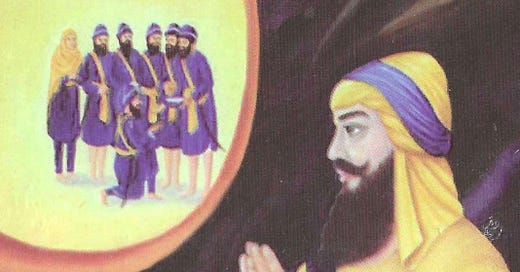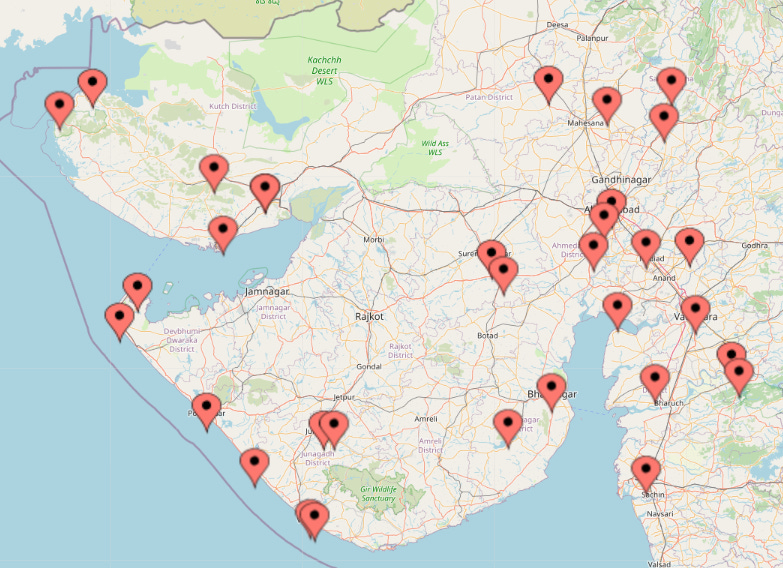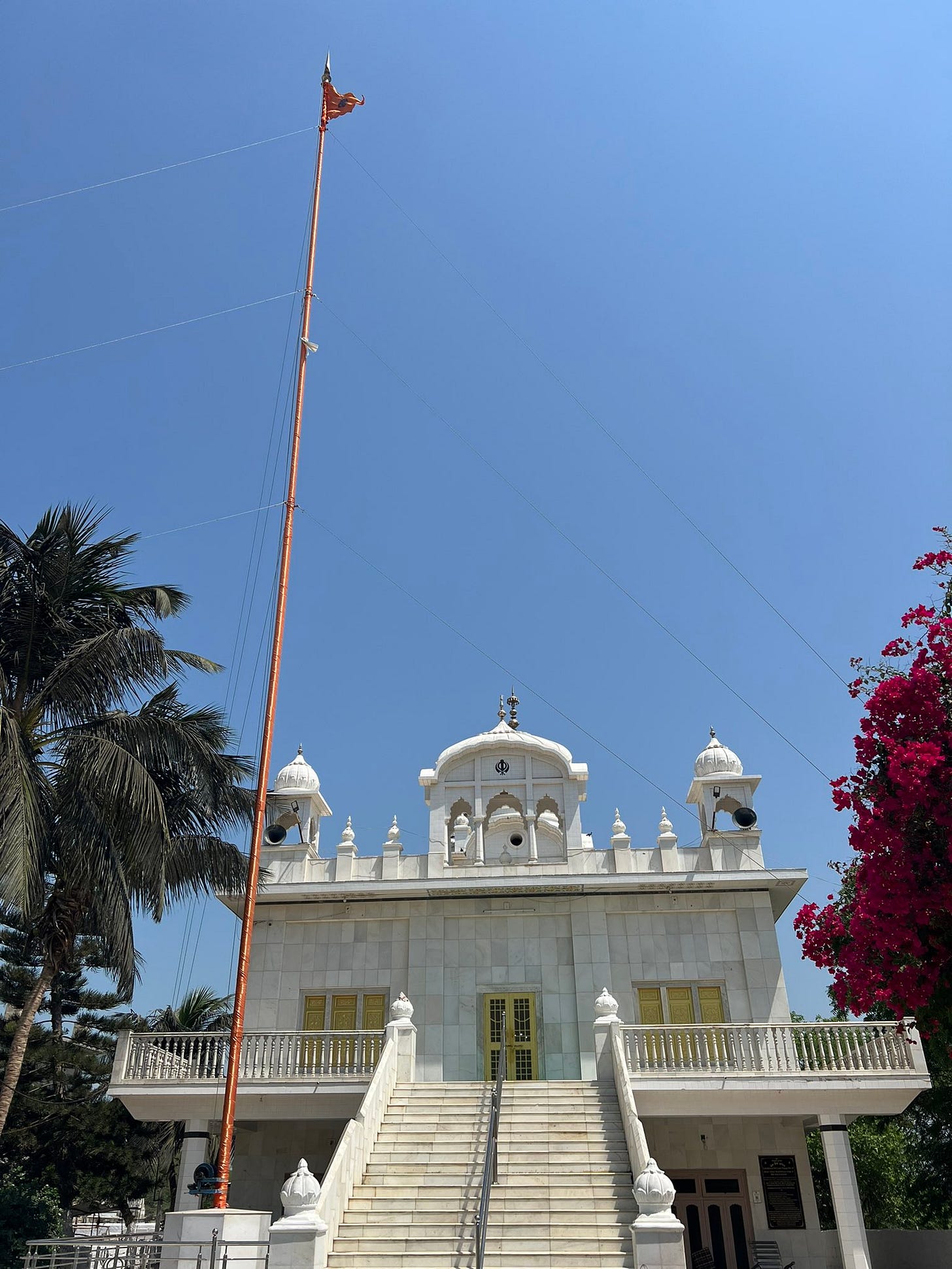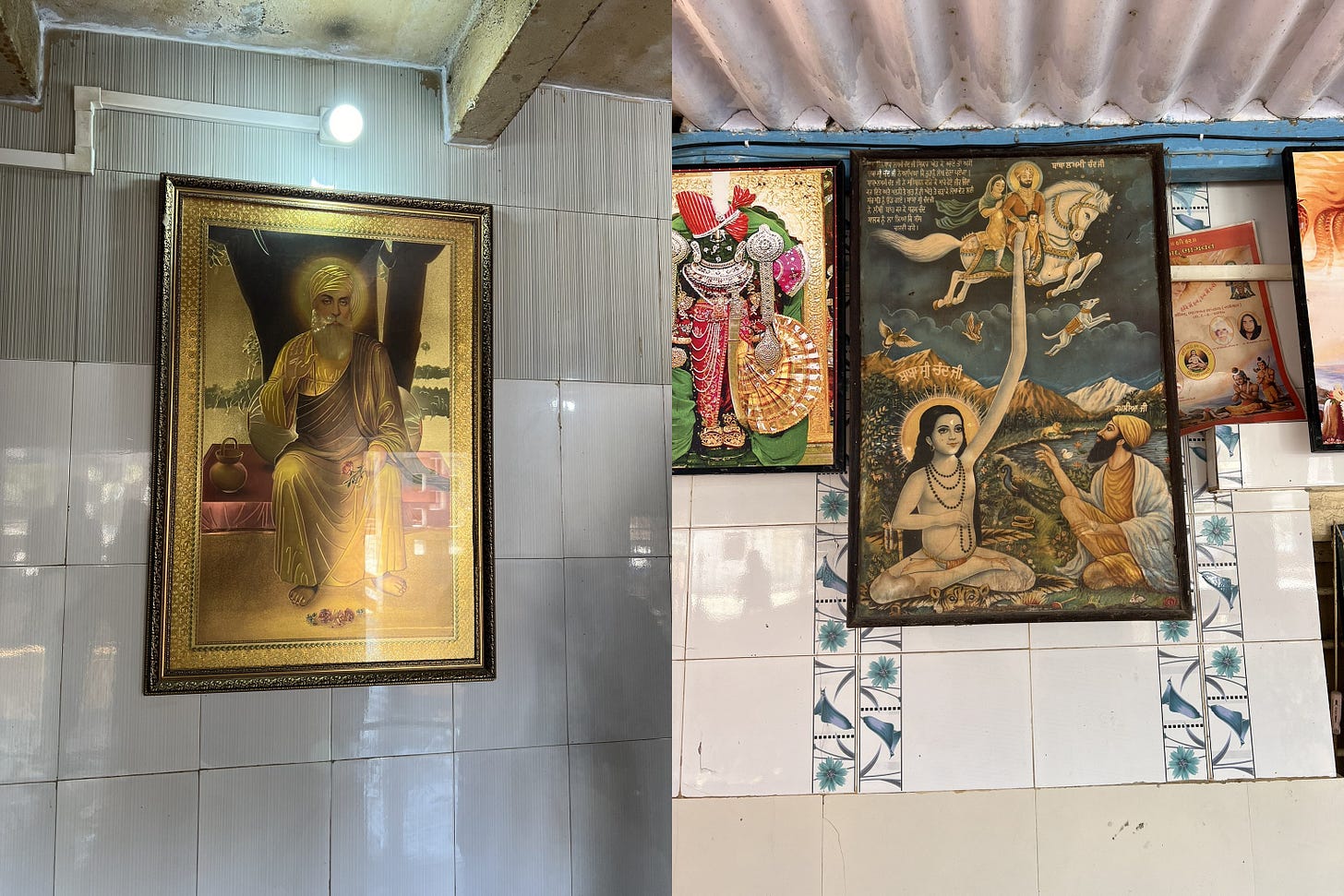The house of Baba Nanak, established across the subcontinent and beyond, mobilised towards Anandpur upon the Guru’s adesh. In the land of five rivers, five heads were given unto the True King. Revealed to the assembled devotees as the very form of the Guru, a brotherhood, cutting across caste and regional divisions, was ordained by the Unseen for righteous war.
Information on the Pyara from Gujarat is scattered and scarce. When consolidated, an account of devotion and sacrifice is woven, beginning with Satguru Nanak’s udasis and ending in the ensanguined fields of Chamkaur.
Saurashtra and the Nanakpanth
Saurashtra, the peninsular region of Gujarat, was a frequent target for invaders much like Punjab. Scythians, Greeks, Rajputs and Turks ventured here in their pursuit of conquest and after the incursions of the Marathas, the land gained the name Kathiawar1. Saurashtra was moulded by these near constant conflicts and the identities of its numerous ethnic groups are intertwined with this bloody history. Each village bears the signs of martyrdom with scores of palia (hero stones) and asthans in honour of their Survirs and Kuldevi, who in Kathiawar takes on a multitude of fearsome warlike forms. As such, weaponry is held in particular reverence by the martial folk of Saurashtra, with a focus on the sword - regarded by all as Shakti manifest.
Rocks at Girnar display the footprints of Tirthankars, the edicts of Ashoka and images of Gorakhnath. Once a stronghold of Buddhism and now a staple on the pilgrimage circuit of Jains and Hindus, the mountain represents a mélange of saintliness across Sorath Desh. Traditions in the name of Bhagat Kabir and Sant Ravidas have flourished there amongst many other unorthodox sects in which it isn’t uncommon for religious and caste boundaries to be erased in favour of the egalitarianism characteristic of the bhakti movement. Their poetic works are immortalised in the santvani bhajan tradition of Kathiawar and the pious culture of the region has inspired several modes within Indian classical music including Raga Gurjari, Sorath and Bilaval2 which are found within the Adi Granth. In the Miharban Janamsakhi, Guru Nanak requests Bhai Mardana to play kirtan in Raga Sorath on their way to Girnar3.
Sorath is forever beautiful, if in the mind emerges the Truth.
-Guru Nanak, Raga Sorath, Adi Granth, Ang 642
The convergence of militancy and spirituality in Saurashtra often gave rise to warrior saints and baharvatiya (outlaws) such as Vinjra Keshwala4 and Jogidas Khuman5. It is then fitting that one of the first Khalsa Sikhs could also emerge from this milieu6. The religiosity of Kathiawar is of significance given that Guru Nanak’s udasis were characterised by a focus on sites of pilgrimage as emphasised in the Mecca and Haridwar episodes from the popular Janamsakhi literature. This mode of operation is thought to have brought the Guru’s travelling mission through Gujarat twice though few sources reliably describe this lesser-explored segment of Sikh history7.
Sangats were established wherever the Guru stayed8 and nurtured further by the arrival of the Udasins who prepared compilations of Gurbani to preach the message of Sikhi9. It is imperative that these manuscripts and any others are found, preserved and studied for within them they contain invaluable information on the Gujarati Nanakpanthis. Parchar of Sikhi sustained the sangats of Gujarat throughout the tenure of the ten Gurus and though there was a subsequent decline, the sangats have begun to increase once again with the presence of Sikligar, Sindhi and Punjabi Sikhs. Very few field studies have been carried out to trace the old sangats but many Gurdwaras have been established in locations associated with the travels of the Guru.
Wherever Baba put his feet, a religious place was erected and established.
-Bhai Gurdas, Varan Bhai Gurdas, Vaar 1
Of utmost relevance is Gurdwara Guru Nanak Dev Ji in Beyt Dwarka, an island in the Halar region of Saurashtra, built near Shankoddhar Kund which local folklore narrates as the location where Dwarkadish Krishna killed the demon Shankasur. The talav is host to a constant flux of devotees who partake in ritual bathing and is thus a destination typical of those visited by the Guru as per the previously established modus operandi10. It is believed that Guru Nanak arrived at island (following his visit to Girnar and the rest of Saurashtra) during the later years of his second udasi and bathed in the kund before preaching a sermon on ੴ which ultimately planted the seeds for a Beyt Dwarka sangat. Matching the theme of the Janamsakhis, a miracle is attributed to this event where the kund becomes the only source of water on the island not requiring purification.
Chaurasi Dhunna Peeth, an ancient site of the Nath yogis supposedly re-established by Baba Sri Chand, is a short drive from that Gurdwara and is amongst many Udasin abodes in the subcontinent linked to Guru Nanak’s travels. The island clearly follows the pattern seen in the rest of Gujarat where sangats established by the Guru were supported by the Udasins. However, the most tangible evidence of the Beyt Dwarka sangat was discovered in land records of the island where the plot overseeing Shankoddhar Kund is noted as the “House of Nanakshahi” 11. A several centuries old structure at this location is said to be the birthplace of the Khalsa from Gujarat.
Muhkam Chand (often anglicised as Mohkam) was born in 1676 to Tirath Ram Chand and Sukh Devi of the Chhimba community. Chhimbas are typically involved in textiles though like many communities seeking upward social mobility, they draw their lineages from Kshatriyas12. Regardless of this projected past, it is clear from later narrations that the Kathiawadi disposition for heroics and saintliness was present within the young Muhkam Chand. What interest could he have had in fabrics? As such, he left the island with his parents at age nine, along with other Beyt Dwarka residents, and sought out the one who is foremost amongst saints and soldiers.

Under the Nishan of Hind Ka Pir
The jatha of Gujarati Nanakpanthis submitted themselves into the service of the Tenth Sovereign who had established a strong literary and martial culture during his stay in Paonta with Raja Medini Prakash. Sikhs from distant sangats were invited to participate as the Guru was not one for idling nor was it permitted amongst his Sikhs. The warrior saint latent within Muhkam Chand was manifest by the hammer of Guru Gobind Singh and forged in the relentless study of Gurbani and warfare. Under careful supervision, the Sikhs of Paonta became well versed in performing a manner of intricate tasks ranging from battle formations to shabad kirtan.
Mukham Chand’s capabilities were soon put to the test. The triumph of the outnumbered Sikhs at Bhangani marked the start of a series of conflicts between the ruling forces and the Guru, whom Mukham Chand served till his last breath. At Nadaun he waged war against Alif Khan’s army alongside the very Bhim Chand he fought at Bhangani and Satishcandra Vyas credits Muhkam Chand with a leadership role in two consequent conflicts with Hussain and Dilawar Khan13 . This detail finds no mention in Guru Gobind Singh’s account within Bachitra Natak. In fact, with the exception of Daya Ram and Sahib Chand, none of the Pyare are mentioned in the Dasam Granth but each of these battles and the subsequent victory of the Sikhs is narrated in great detail by the Guru.
The trumpets resound in the field and the minstrels sing their heroic ballads, the bodies are pierced by arrows and the headless trunks are moving in the field. The blows of maces on helmets create knocking sounds, the bodies of killed warriors are rolling in dust.
- Guru Gobind Singh, Bachitra Natak, Dasam Granth, Ang 146
Relations with the Pahadi Rajas had reached their nadir. The proliferating tyrannical excesses of Aurangzeb after the execution of Guru Tegh Bahadur had strained the Mughal-Sikh dynamic heavily. Despite instances of reverence and fruitful bonds between the three communities during the stewardship of previous Gurus, the Plumed One understood now that further escalation was inevitable and that the Sikhs would need to be able to withstand consequences of this. What followed next needs no deliberation.
His name become known as Muhkam Singh of Bhagat Namdev’s Chimba caste. He was a resident of Dwarka and was learned in all the sciences and had adopted Sikhi.
He said “Take my head and forgive me for taking so long to stand up.” Hearing this, the Guru took his hand and took him inside the tent.
-Kavi Santokh Singh, Gurpartap Suraj Granth, Rut 3
The founding of the Khalsa in the month of Vaisakh is perhaps the most defining moment in Sikh history. With the participation of goats, the Guru enacted a wonderous play to test his Sikhs and in the midst of the masses panicking and even fleeing from the gathering, Muhkam Chand followed his brothers into the Guru’s tent and thus into history. They became the very form of the Guru and to this day occupy an exalted position as showcased by their position in the Ardas between the ten Gurus and the four martyred children of Guru Gobind Singh.
The establishment of the Khalsa was shortly followed by a thwarted assassination attempt on Guru Gobind Singh. Combined with his ordaining of a military order, this failure heightened pre-existing insecurities amongst the hill kings who then approached the Mughals for assistance in subduing the Guru. Such a demonstration of fickleness against the one who had intervened in their prior conflict with the Mughals failed to bring the Rajas any success. Muhkam Singh, now aged 24, was tasked with organising and training the newly formed Khalsa panth owing to his aforementioned military success and each of the Pyare were deputed with the command of their own unit. Though lesser in number than the Mughal army, the Pyare led their soldiers in pursuit of Din Beg as far as Rupnagar whilst Painde Khan gained mukti by the Guru’s own sword.
In the wake of this defeat, the hill rajas combined their forces and laid siege to Anandpur during which Muhkam Singh once again commanded his own unit. The siege was unsuccessful and the Sikhs would win a further two battles at Basoli and Anandpur under the command of the Pyare. The Mughal-Raja alliance laid siege to Anandpur once more, this time with greater strength. Guru Gobind Singh entrusted the manning of Anandpur’s forts with his most trusted Sikhs and the responsibility of Qila Holgarh fell upon Muhkam Singh.
Besieged for months, facing starvation and desertion, the Guru received assurance of safe passage for himself and his Sikhs to evacuate Anandpur. Despite oaths sworn on the Quran and Gau Mata, the Sikhs were betrayed and attacked on the banks of the Sarsa. Some were struck down in battle whilst others perished in the river. Countless manuscripts from the Anandpur Darbar were lost and the Guru’s relatives were separated. This treachery resulted in heavy losses for the Sikhs and by the time the river had been crossed, only forty remained with the Guru including the Pyare and his two eldest sons.
Saka Chamkaur
With the Mughals in relentless pursuit, the Guru and his men took shelter in the village of Chamkaur where they fortified a haveli in anticipation of a last stand. As the popular tale narrates, the Sikhs ventured into battle in groups of five and caused mayhem disproportionate to their small numbers. However there was one who broke the pattern and descended upon the battlefield alone. The martyrdom of Muhkam Singh has been described in great detail by Santokh Singh in Rut Six of the Suraj Prakash Granth14.
Muhkam Singh was a great forbearing warrior who had himself taken and distributed the Pahul. He attained great delight on behalf of the Guru and said "I shall exit the fort alone. You must watch the war waged by me with your grace." The perfect Guru Ji gave the command "One brave Singh can fight against thousands, now you must prove this statement true. Kill countless enemies and throw them to the ground."
Hearing this command, he exited the fort. Then iron clashed with iron tremendously. The barbarian army was like a vast ocean in which Muhkam Singh was a crocodile. Then roaming from side to side, Muhkam Singh entered among the army. He caused great perturbation among the entire enemy army. The large attacks called by the enemies are like ripples. The crocodile-like Muhkam Singh has lifted his sword. Whoever he stood forth offering a challenge, he would tear their body in half with his sword. The great warrior's face was full of great rage. Nobody could stand near him as if he was death itself. He attacked with spears, pikes, lances and javelins, killing the enemies whilst embodying great rage.
Jumping side to side dodging their attacks, he would gash the enemies with his sword. In whichever direction he would run, enemies would run in the opposite direction in fear. There was redness on the face of the fearless and elegant warrior. Both his beard and moustache appeared very graceful. He had manifested a very fearsome form as if he was Yama. Consider his sword as the punishment of Yama, the god of death. Upon killing countless enemies, he became very injured. He became very pleased upon seeing his blood flow out. His clothes became drenched in blood, but his body still embodied fortitude. The transcendent warrior roamed around amidst the enemy army.
As he had churned the large army akin to an ocean, then Khwaja Mardood yelled out in anger. "What has happened to you, why have you lost all your strength? Even the thousands of you have not been able to kill just one Singh." Then, very rapidly, many guns started firing. Thousands of bullets were fired at once. Twenty to twenty-five bullets strike Muhkam Singh, his body had gotten badly wounded in all places. He died whilst still standing, then fell forward. Filled with Bir-Ras, he did not even step back a single inch. Seeing the war waged by Muhkam Singh, Guru Ji remained very pleased. They said countless praises in favour of their devout Sikh. Causing great clamour and uproar, he fought a tremendous battle. At that time, lots of iron clashed with iron. In this way, Muhkam Singh left for heavenly abode.
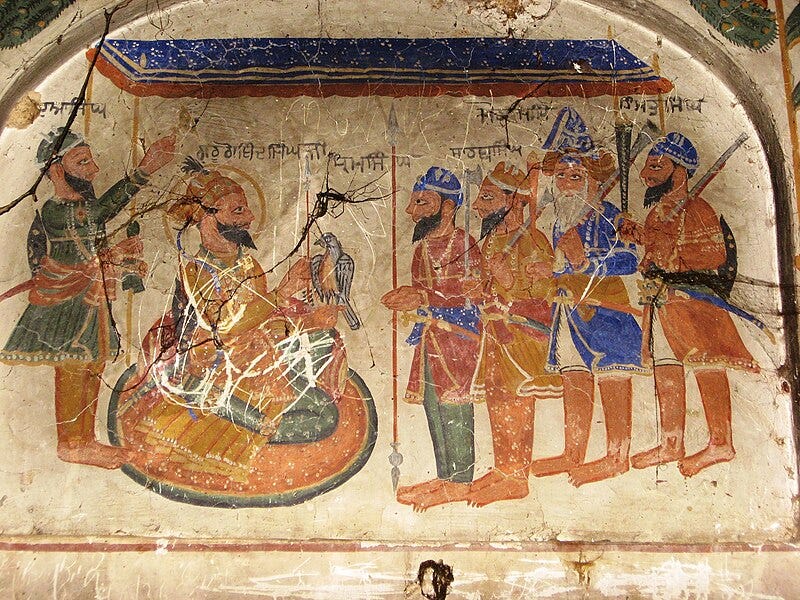
Analysing Traditional Narratives
A problem that arises when attempting to trace the history of the Pyare is the fact that they are simply absent from sources dated after the creation of the Khalsa and the earliest sources on this event do not mention the pyare at all. The five individuals do not appear until the end of the 18th century in which their names, birthplaces, castes and “karmic alignments” are described with Muhkam Singh introduced as hailing from Dwarka and the reincarnation of his caste fellow Bhagat Namdev. The remaining four are similarly given previous lives as noted saints with their birthplaces stretching all over the Indian subcontinent.
As the 19th century unfolded, Sikh texts removed any references to the castes and previous lives of the Pyare but retained their places of birth. Where their castes were previously described to emphasise the cosmopolitan nature of the Khalsa, they were later omitted to serve the same purpose. By the 20th century, Sikh historians did not only exclude previous lives of the Pyare but openly ridiculed the concept though this aversion to the “Hindu” associations of the Pyare seems to be a misunderstanding of what may have originally been intended by these alignments.
Furthermore, their birthplaces were uprooted from across the subcontinent and relocated to villages within Punjab. This historical transportation has not gained currency amongst scholars as numerous hukamnamas of Guru Tegh Bahadur and Guru Gobind Singh acknowledge sangats in distant lands and the discovery of the “Nanakshahi” community in Beyt Dwarka land records supports the traditional narrative further. It is likely this change in history was motivated by the growing assertion of the Punjabi-Sikh identity at the time and any evidence for it, if supplied at all, is unsubstantiated. A full dissection on Sikh sources and the point at which the Pyare emerge as a construct is beyond the scope of this article but has already been approached in Fenech’s work on the matter15.
Muhkam Singh’s alignment with Bhagat Namdev reaches beyond caste and transmigration as he is said to have been born in Dwarka, the residence of Namdev’s beloved Krishna16. The folklore of Saurashtra depicts Namdev’s Krishna as drawing upon Harsiddhi Mata to defeat Shankasur and a parallel can be seen with Sikh texts that depict Muhkam’s Guru as drawing upon Naina Devi before forming the Khalsa. Debates on the historicity and religious implications of the latter event are settled by the context of the former in view of the fact that within the Indic kingship, Durga takes on a political role as the legitimiser of kings and justifier of war17. This is of immense relevance as the notion of kingship was one of Guru Gobind Singh’s most substantial drivers in the formation of the Khalsa.
The Guru became ultimately pleased with these Sikhs, they appeared like Krishna with the five Pandavas in Dvapara. The bliss and greatness increased, it was like when Yudhishthira and the other Pandavas met with the sixth, Krishna.
-Kavi Santokh Singh, Gurpartap Suraj Granth, Rut 3
In many sources, the Pyare are aligned with the Pandavas and the Gurus themselves drew upon the Mahabharata within their writings as the popularity of the legend provided a vehicle for them to reach the lay person with their didactic compositions. When associating the Khalsa with the Pandavas, Sikh writers were perhaps suggesting that the Guru’s battles were akin to the dharam yudh described in the Mahabharata and also positioning the Khalsa to inherit the righteous rule of the Indian subcontinent that the Pandavas were exemplars of 18. This idea is given an interesting dimension by Giani Gian Singh who refers to the Pyare as uprooting the four Rashidun Caliphs of Islam and replacing them19. It is for this same reason that the Pyare were also depicted as the reincarnations of prominent “Hindu” saints, to impart the spiritual and temporal authority of widely revered figures onto them. Their presentation as a quintet rightfully brings to mind not just the five Pandavas but the first five followers of the Buddha, the Panj Pir and the panchayat system of governance, all of which associated the Pyare with a dharmic past that they would fulfil in the future. Considering this, the criticism of these associations emerging in the 20th century appear short-sighted.
Thus, it can be seen that throughout Sikh historical texts, the Pyare exist as an expression of the Khalsa’s potential rather than as specific historical individuals and the emphasis on their birthplaces reflects the aspirations of Sikh writers as well as the Guru’s vast geographical ambit. The order in which they offer their heads varies between sources owing to social changes in the Sikh world and at times even the names vary, with the Dwarkavasi Pyara named as Nihchal in the Gurbilas of Koer Singh. While this is perhaps more realistic than the Farsi Muhkam, the fact that both names are variants of the same definition has resulted in the suggestion that the names of the Pyare are reflective of ideals (compassion, duty, courage, steadfastness and mastery) rather than historical identities.
This need not mean that Guru did not draw upon distant sangats when creating the Khalsa, but simply implies that the individuals that comprised of it were not as important as what they represented for the collective.
Closing Thoughts
Unlike other fallen sons of Saurashtra who are memorialised with palia, the Heer of Halar Muhkam Singh is immortalised in the collective memory of the Sikhs as expressed by his memorials at Gurdwara Guru Nanak Dev Ji in Gujarat and Gurdwara Garhi Sahib in Punjab. The Beyt Dwarka Gurdwara has been operational since its foundations were laid in 2003 and is constantly expanding facilities for the sangat including accommodation despite its remote location and distance from a prominent Sikh community. With the construction of the Sudarshan Setu bridge that connects Beyt Dwarka to the mainland, the birthplace of Bhai Muhkam Singh is now accessible to even the most distant of travellers.
In light of the questions that arise on the historicity of the Pyare, the author travelled to Beyt Dwarka in search for the Guru’s Pyara. As such, the reader is now implored to seek out evidence of the Nanakpanth in Bidar, Puri and Hastinapur and perhaps even genealogical records for individuals such as Daya Singh in Lahore. Regardless of what may or may not be found, tracing the footsteps of Satguru Nanak will certainly enrich oneself.
Wilberforce-Bell, H. (1916). The History of Kathiawad from the Earliest Times.
Françoise Delvoye (2013). Music Patronage in the Sultanate of Gujarat: A Survey of Sources. Routledge eBooks, pp.342–360. doi:https://doi.org/10.4324/9780203039199-17.
Kirpal Singh (2004). Janamsakhi Tradition. Singh Brothers Amritsar.
Keshwala, R.M. (1944). Maher Javanmard. Gujarati Vidyapith Library.
Meghani, J. (2021). Sorathi Baharvatiya (Sankalit). Gurjar Sahitya Bhavan.
The founder of the Pranami sect Mehraj Thakur, Prannathji, preceded Muhkam Singh by six decades and was born in the same region of Saurashtra (Jamnagar District). The saint warrior Prannathji became the guru of the Bundela king Chhatrasal and guided him in a struggle against Aurangzeb and the Mughals during a time in which the House of Babur was also under attack from the Sikhs, Rajputs and Marathas.
Singh Grewal, D. (1994). Guru Nanak’s Travels Through Gujarat. Sikh Review.
These locations are often referred to as “Nanak Wadi” and many Gurdwaras in Gujarat, and indeed beyond, contain this phrase in their names.
Singh, B. (2010). The Sikhs in Gujarat. Sikhs Living in States Other Than Punjab.
The founder of the Pushtimarg, Vallabha, was known to travel throughout India to preach at places of pilgrimage much like Guru Nanak and other saints of the bhakti era. At each site, a “Baithak” was established to mark his visit and one is found next door to the Gurdwara where he visited the kund in 1527, not long after the Guru.
Vyas, S. (2013). Adi Panj Pyare Bhai Mokham Singh Ji Saheb.
Like many castes in India, the Chhimbas/Chimpas apply a Puranic flavour to their origins. As per their myth, two princes took refuge in a mandir during Parshuram’s genocide of the Kshatriyas and one hid behind idols of the deities. The Chimpa trace their ancestry to this individual and so their community was named after the word for hiding “chhip”. Another variation of this tale exists in which the grave threat is not Parshuram but the invasion of Tamerlane.
Vyas, S. (2013). Adi Panj Pyare Bhai Mokham Singh Ji Saheb.
Jvala, S. and Jaspreet, K. (2025). Suraj Prakash Granth ∼ SPG ∼. [online] Spg.dev. Available at: https://spg.dev/chapters/1173.
Also beyond the scope of this article, but worth mentioning, is the prominence of the number five within Sikhi and wider Indic culture (panj khands, tahkts, mel, chor, jnanendriyas, bhut etc).
tijo muhkam singh davarka jayo. namdev avtar su ayo.
-Ratan Singh Bhangu, Sri Gur Panth Prakash
Bihani Sarkar (2017). Heroic Shāktism : the cult of Durgā in ancient Indian kingship. Oxford: Oxford University Press.
Sections of the Dasam Granth that detail the wars fought by the goddess Chandi and other demigods may also be seen in this light, where the Guru aligns his struggles and battles with those found in Puranic literature and Indic mythology.
Singh, G. (1885). Twarikh Guru Khalsa.

